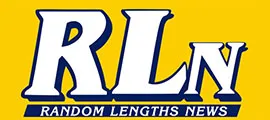By Andrea Serna, Arts and Culture Writer
A decade ago, author Ekhart Tolle brought the concept of ‘now’ into popular psychology with his book The Power of Now.
Artist Jay McCafferty preceded Tolle with a practice of art that necessitates presence of spirit, focus and mindfulness that would test all but the most dedicated Zen practitioners.
In September, curator and artist Ron Linden opens an exhibition of McCafferty’s work at Warschaw Gallery in San Pedro.
The exhibition visits McCafferty’s new solar-burned, process driven paintings. Working outdoors, using a magnifying glass and the sun’s heat, he burns holes of various sizes into stacked sheets of vellum paper. Depending on the intensity of the sun and other atmospheric conditions, McCafferty can create a variety of effects. The burns in the paper leave behind a smoky residue that adds a painterly quality. The resulting works can be delicate and lace-like, or aggressive as detritus in the remains of destructive fire.
McCafferty needs to be in the moment, let the work of art reveal itself through action. He sets the stage mentally and physically with preparation of the paper, then focuses on being present and lets the art unfold and develop.
“These works have a certain passivity and tranquility to them,” Linden said. “He is masterful with what he does. There is no preordained design or composition in his work. He begins and works until the sun goes down and next day takes up where he left off.”
McCafferty’s choice artwork can be described as ‘Process Art’ – art that emphasizes the process of its making. His interest in process and the properties of his materials are determining factors in his aesthetic and has precedence in the abstract expressionists use of unconventional methods such as dripping, pouring and staining.
McCafferty has always followed his own intuition in his works.
“My work originated in the early 70s,” McCafferty said. “The zeitgeist of the time was process oriented and that was primarily the time frame that I came out of. It is something that has been part of my work for most of my career. I have a strong theory that everything is ‘right now’. You can hypothesize about what happened before and fantasize about what is going to happen, but one thing I know for certain is right now is all that exists.”
He also believes there are no accidents. The magnifying glass is a device that has become more mysterious to him over the years. He has learned, over many years of practice that he cannot use the method unless he is paying complete attention. The artist’s attention is ‘magnified’ by the lens. When we spoke recently, he had just spent six hours on one piece. A completed work can take as much as three months to finish.
Sandy Ballatore in Art in America writes that the works are “the gridded, singed, skeletal remains of his own peculiar art-making ritual: sitting on his studio roof, magnifying lens in hand and sun overhead, he ignites papers, plastic, wood, cardboard … in a mechanical meditative rite.”
McCafferty also is a pioneer in the field of video art. Eventually he became discouraged by the reluctance of galleries to show video in its early days and concentrated on painting. His art is now shown in museums and galleries across the United States and Europe.
His trust in Linden is a primary reason that McCafferty is showing his art in San Pedro.
“I was born in San Pedro,” McCafferty said. “I never thought there would be an art reality for me there. It wasn’t part of the tradition that I grew up in. The art world was always someplace else. The idea that there is somebody here [who] I like and respect is wonderful. I never thought San Pedro, or even Los Angeles, would ever be a distribution center. Even though most of the major sales [in the past] were in New York, most of the major ideas primarily came from the West Coast. We have less tradition hanging over our heads.”
As a young artist in the 1970s, McCafferty developed a practice that became a groundbreaking trend in the 21st century. In 1972, he acquired a Sony Portapack camera and turned it on himself shaving in his bathroom mirror each day. He has been doing that for the past four decades. He has never stopped.
Decades of technical evolution forced him to adjust his video practice. A recent viewer commented that his work was akin to the Rosetta Stone of video work. He states he has owned eight or nine cameras, moving from the original Sony Portapack to digital as time progressed. During the process he also documented the decades long evolution of Gillette shaving equipment.
Richard Linklater’s film, Boyhood, and Michael Apted’s film, Up, are examples of our fascination with documenting our lives throughout extended time periods. Our current access to video technology on the cell phone we carry in our pockets has made us the most highly documented generation in history. McCafferty was essentially a visionary in this field.
He was the first video artist to be shown at the Long Beach Art Museum, which in the 70s established a reputation for exhibiting artists working in the experimental medium. Years later, the Long Beach Museum of Art realized they had neither the technology nor the staff to preserve the large video collection gathered.
The Getty Museum acquired the collection in 2005. It is an important record of the early and continuing history of video art and a crucial component of the region’s cultural history. Containing numerous masterpieces in the medium, the collection comprises the largest gathering of video art works produced in Los Angeles and Southern California. Pioneers of the art form, such as John Baldessari, Bill Viola and Jay McCafferty, are represented.
Jay McCafferty, Recent Works, opens at TransVagrant @Warschaw Gallery with an artist’s reception at 4 p.m. Sept. 13.
Details: (310) 600-4873
Venue: TransVagrant@Warschaw Gallery
Location: 600 S. Pacific Ave., San Pedro



